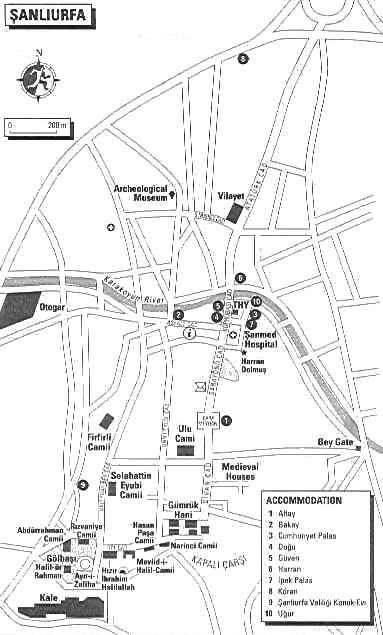Şanlıurfa - Edessa
 Şanlıurfa
claims connections with Abraham and Nimrod, and with 1st century Christian missionaries.
Its mosques reflect the Muslim presence here from the 12 century on. Perhaps it was the
capital of a Mitanni kingdom in the second millennium BC. In the succeeding centuries
Hurrians, Hittites and Assyrians must have been its rulers. Şanlıurfa
claims connections with Abraham and Nimrod, and with 1st century Christian missionaries.
Its mosques reflect the Muslim presence here from the 12 century on. Perhaps it was the
capital of a Mitanni kingdom in the second millennium BC. In the succeeding centuries
Hurrians, Hittites and Assyrians must have been its rulers.
Alexander the Great came through here in 333
BC; his inheritor and General Seleucis renamed the place Edessa, referring to a city he
knew in Macedonia. It was called that through the time of the Crusades. "Urfa"
harks back to the earlier name. Since the Turkish Revolution of 1923 it has acquired the
distinguishing title of "Şanlı" - "Glorious" Urfa.
Two late-Roman columns part of what is called the "Throne of
Nimrod," rise prominently on the hill southwest of the city; one bears an inscription
in Syriac concerning Queen Shalmat, but who she was has not been established.
Şanlıurfa claims the distinction of being the birthplace
of Abraham. One of its early names, "Hurri," which is thought to mean
"grotto" or "fortress with a spring," is related to the legend that a
cave under the citadel of the city is his birthplace. In Muslim tradition this was where
Abraham rebuked King Nimrod and his subjects because of their worship of idols (Sura
vi:74- 79). For the insult and his refusal to follow the kings practice, Abraham was
condemned to be burned. But God turned the fagots for the pyre into carp and the flames
into two pools. These pools are considered sacred by the
residents of Şanlıurfa and the tradition makes it a place of pilgrimage for Muslims.
The Christian influence in Edessa, according to the 4th century Christian
historian Eusebius, began when King Abgar V (4 BC AD 50) addressed a letter to Jesus
asking him to come cure him of his leprosy.
The oldest Muslim building in Şanlıurfa is from the 12 century: Ulu Cami
("Great mosque"), a red stone building on Ataturk Caddesi, was founded by
Nureddin and patterned on the Great Mosque of Aleppo; its minaret doubles as a clock
tower. (Nureddin was the ruler of Aleppo and Damascus.) The medrese (Islamic school)
associated with it is thought to have been built by Saladin in 1191. Other old buildings
date back to the 13 century. Reflections of the religious complex of the Mosque of Halil ar-Rahman and of its medrese shimmer in one of
the sacred pools associated with the memory of Abraham. Tradition says that anyone so
sacrilegious as to eat the fish of this pool will go blind. The Ridvaniye Camii and its
medrese and the Abdurrahman Camii and its medrese are from the 18th century. Not far from
the pools is the old bazaar, a place whose crowded streets, whose goads and whose methods
of manufacture, whose sounds and smells and hubbub, whose merchants, their costumes and
their bargaining are reminiscent of the fabled romance of the old Ottoman Empire.

|